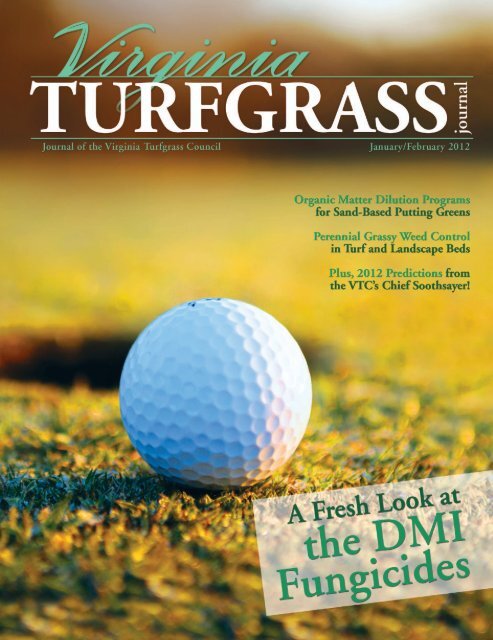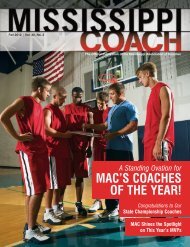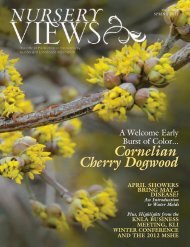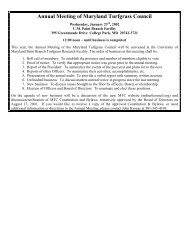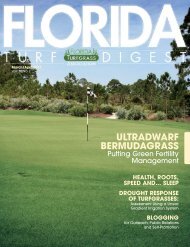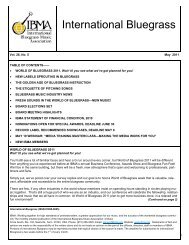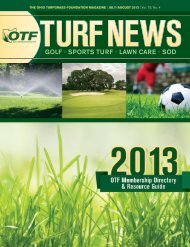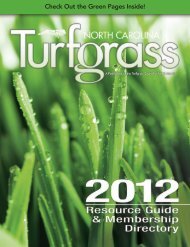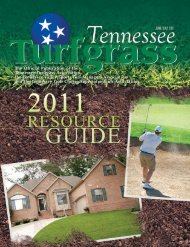Virginia Turfgrass Council / PO Box 5989 / Virginia Beach, VA 23471 ...
Virginia Turfgrass Council / PO Box 5989 / Virginia Beach, VA 23471 ...
Virginia Turfgrass Council / PO Box 5989 / Virginia Beach, VA 23471 ...
- No tags were found...
Create successful ePaper yourself
Turn your PDF publications into a flip-book with our unique Google optimized e-Paper software.
Journal of the <strong>Virginia</strong> <strong>Turfgrass</strong> <strong>Council</strong> | January/February 2012221212 Cover StoryA Fresh Look atthe DMI Fungicides26DEPARTMENTS6 Director’s Cornerfrom Tom Tracy, Ph.D.8 Editor’s Perspective16 Feature Storyfrom Mark Vaughn, CGCSOrganic Matter DilutionPrograms for Sand-Based10 VTF Reportfrom Betty ParkerPutting Greens in <strong>Virginia</strong>28 In Memory22 Turf TalkPerennial Grassy Weed29 Industry NewsControl... I can do this!30 <strong>Turfgrass</strong> CalendarWait, how do I do this?30 Index of Advertisers26 Applied ResearchBetter Turf for a Better Gameat Kinlock Golf Club4| VIRGINIA TURFGRASS JOURNAL January/February 2012 www.vaturf.org
2012 Prediction #2After trying “Play Golf America,” “The First Tee,” “TeeIt Forward,” “Take Your _______(Daughter, Son, Dog)to the Course,” “Please Come and Play, We’re GoingBroke,” etc. campaigns, the golf world finally gets it.A clever manager in Southside <strong>Virginia</strong> (of all places)rebrands the course as the “Goodyear Carbon Sink.”Environmentalists (term loosely used) from all partsarrive by the hundreds in old tie-dyed school buses tomarvel at this new miracle of modern science.“Would you believe…” bellows the manager ina carnival-barker-esque tone while leading the touron his Honda U3-X (check it out on YouTube) “…that there are over 38 MILLION little carbon-eatingmachines on each acre here at ‘The Sink’? Thatwildlife abounds, that clean water runs, that soil isstabilized, that wetlands are established, that theair is cleaned and renewed, that grandparents andgrandchildren can enjoy each other’s company insuch a marvelous setting, all the while learning a gamethat teaches them honesty, perseverance, etc., etc.?”2012 Prediction #3Here’s my annual Masters prediction. Some idiot yells,“GET IN THE HOLE” on the tee of the 455-yard, parfourfifth hole. He is promptly dragged down to thepond on sixteen and buried waist deep in mud, andthere he stays for the remainder of the week. It makesthe annual ball-skipping contests across the pond muchmore exciting. In other news, no one yells out stupidcrap at tournaments the remainder of the year.2012 Prediction #4Rejuvenated by his successful fundraising efforts onbehalf of the “P” party, Tiger Woods goes on a tearand wins the first three majors of 2012, putting himone shy of Jack’s record. Golf is put on hold, however,as he is announced as the vice presidential candidatefor the P party. “Jack’s record is okay, I guess, buthaving Herm AND me in the White House? NowTHAT’S a record,” he says.2012 Prediction #5The USGA announces that the site for the 2012 Openwill hence be known as the “Olympic Carbon Sink.” Inan about-face, San Francisco residents drop plans totry and close Sharp Park Carbon Sink, formerly knownas the Sharp Park Golf Course. They instead shift theiranger to the tourist trap known as Fisherman’s Wharf,demanding that the city bulldoze the site and haul inhundreds of loads of dirt and sod to establish anothercarbon sink downtown.2012 Prediction #6Just as it looks like our industry is on a roll, hundredsof job losses take place as sups are replaced by thenewest Apple creation. “Now when we have problems,”exclaims an excited Bentley Brazelton (chairman ofthe Emerald City Carbon Sink), “we just tell all thepertinent facts to ‘Siri,’ and badda-bing, badda-boom,we have our answer. No more ‘excuses’ like, ‘Well, itis 102 degrees, and you want the greens stimping 13’or ‘We just had a three inch thunderstorm’ or ‘Gravitymakes greens faster downhill than uphill,’ that we usedto get from that overpaid, pickup-truck-driving clown.Why, just yesterday, I told Siri our greens were brownand slow, and she recommended water, fertilizer andlowering the mower. As I’ve said all along, any monkeywith a bunch of bananas…”2012 Prediction #7TV golf commentators will say for the umpteenth time,“Let that be a lesson to all you amateurs out there.If you are not ready to play a shot, step back and gothrough your WHOLE routine again.”Yes sir, Einsteins, that’s just what we need. More slowgolfers. Makes you want to see Ricky Fowler climb thetower and throw Gary Koch, et al., out on their heads.2012 Prediction #8President Obama ups the ante by announcing that, ifhe’s reelected, he will indeed replace Joe Biden withthe Big O from Chicago, Hillary Clinton with ArethaFranklin, Kathleen Sebelius with Chaz Bono, and LeonPanetta with U2’s Bono. The “Godfather” counterswith Dave Chappelle and the Wu Tang Clan. This isone election when we will be looking forward to thecampaign ads.2012 Prediction #9GCSAA CEO Rhett Evans wins the Ironmancompetition in Hawaii and brings the association morepublicity than it could ever garner otherwise (sidebar:he actually does run in Ironman competitions). Hethen throws down the gauntlet to the CEOs of theFirst Tee, PGA of America, PGA Tour and CMAA,challenging them to a winner-take-all-golf-relatedrevenueTough Mudder in the Louisiana bayou.Well, that’s it for another year. Sit back, and watchthe magic unfold. Oh, I almost forgot to mention: ifyou’d like to be a PREMIER partner, which entitles youto our financial predictions for 2012 and a free palmreading, please send a $150 faith gift to 1901 GoodyearBlvd., Danville, <strong>Virginia</strong>. No checks, please. cJournal of the <strong>Virginia</strong> <strong>Turfgrass</strong> <strong>Council</strong> | 9
VTF ReportNEW LEADERSHI<strong>PO</strong>P<strong>PO</strong>RTUNITIESWITH THE VTFBetty ParkerVTF ManagerThispast fall, the <strong>Virginia</strong> <strong>Turfgrass</strong> Foundation board of directorsvoted to change the bylaws for the Articles of Incorporation toreflect their desire to increase the number of voting members. Bya unanimous vote, the new bylaw adaptation calls for nine voting members instead of seven.Three of our members come to us as ex-officio directors representing the pastpresident, the current president and vice president of the <strong>Virginia</strong> <strong>Turfgrass</strong> <strong>Council</strong>.We feel it is imperative that, as a sister group to this organization, the VTC knowhow and why money is being raised and disbursed for <strong>Virginia</strong>’s turfgrass research.Since 1988, when the VTF was founded, we have had a total of only seven directors:these three ex-officio directors and four at-large directors who serve four-year terms.Because we wish to encourage new candidates as officers in the Foundation, we felt itwas necessary to have a bigger pool of directors from which to draw.Coming on as a new member of any organization takes time and dedication to the goalsand mission of that organization. The ex-officio directors do not serve as officers in the VTF,and we did not feel it was reasonable or responsible to ask virtually everyone else whoserves as a director to eventually step forward as a vice president and, ultimately, president.The revised by-laws allow for six at-large directors and will give us a more reasonable poolof candidates for those wishing to extend their terms to six years and serve as an officer.In making this change, it was also our goal to allow for a greater variety of input.It has always been our desire to represent the entire turfgrass industry. In doing so,we look for candidates who represent golf course superintendents, sports turf managers,sod producers and vendors serving the turfgrass industry, as well as city and private-propertyturf managers. If you or someone you know has an interest in serving your industry andmaking sure that the best possible turfgrass research is funded to its full potential, give mea name and phone number, and I’ll see that the VTF board receives the suggestion.We appreciate all of you who have the privilege of working in this industry, and wewant to provide the best possible scenario for funding the turfgrass research that benefitsall of you. We hope each of you has an opportunity to talk with one of our members inthe near future to learn more about us, or to just share your thoughts and concerns.Our 2012 slate of officers and directors is listed below.OfficersJimmy Rogers: PresidentAdam Dixon: Vice PresidentLin Diacont: Secretary/Treasurer(non-voting member)DirectorsDick FisherSam CogginShawn BasquetteDan McGroryMelissa Reynolds (xo)Frank Flannagan (xo)Rick Viancour (xo)For questions or suggestions, please talk to one of our board members, or you may callme at 757-574-9061. c10| VIRGINIA TURFGRASS JOURNAL January/February 2012 www.vaturf.org
Cover StoryBy David McCall, Research Specialist, Dept. of Plant Pathology, <strong>Virginia</strong> TechForyears, weseemedto knoweverything there was to knowabout ergosterol biosynthesisinhibitors, or more commonlyknown as demethylation inhibitors(DMIs). Propiconazole (Banner),triadimefon (Bayleton) andmyclobutanil (Eagle) were staplesof most turf managers’ fungicidearsenal. Fenerimol (Rubigan)certainly had its place in themarket, and people were relativelycomfortable with its uses andlimitations. Turf managers hadused these products repeatedlyover the years, and they knewwhat to expect. Not much reallychanged for well over a decade.Over the last three years, however,the turf market has seen thelaunch of three new active ingredientsin this class: metconazole(Tourney), tebuconazole (Torque,Quali Pro Tebuconazole) andtriticonazole (Trinity and Triton).Along with a new set of productscomes a new set of questions.Will disease control be the same?Will growth regulation still occur?Can these products be used inrotation with the older DMIs?Can plant growth regulators stillbe applied in conjunction withthese products?While all of these DMIs havesome similarities, each producthas unique advantages and disadvantages.For instance, most of thenewer DMIs have increased activityagainst anthracnose and brownpatch, compared with some of theolder chemistries, but they oftenlag behind in controlling dollarspot. As with the older generationof DMIs, the newest additionspose some potential for someturf injury. Injury and/or growthregulation is most frequentlyobserved on golf course puttinggreens, but it is seldom a problemon higher-cut turfgrasses.Generally speaking, the newgeneration is considered to besafer, with reduced risk of anyobjectionable injury. I have seen12| VIRGINIA TURFGRASS JOURNAL January/February 2012 www.vaturf.org
examples of each product, however,that have given cause forconcern. In each of these cases, Ifeel that injury could have beenprevented if handled differently.I have noted mild injury frommetconazole and triticonazolefollowing multiple (3+) continuousapplications at high labeledrates (and above) on bi-weeklyintervals during the summer. Thisshould not be a common practicefor turf managers, but it was donein the interest of research (I getto do dumb things with productsto test the limits!).I have also seen rare cases wheretebuconazole caused significantinjury to annual bluegrass. Inthese situations, the product waseither applied above the labelrate (currently, 0.6 fl. oz./1,000ft 2 is the only labeled rate) or inconjunction with another productthat caused stress to the turf.DMI applied at 2 gal./1,000 ft 2Aug. 24, 2011. <strong>Virginia</strong> Tech G.C.Banner Maxx(propiconazole)Bayleton SC(triadimefon)Eagle EW(myclobutanil)QP Tebuonazole(tebuonazole)Tourney(metconazole)Trinity(triticonazole)Triton Flo(triticonazole)Figure 1. Comparison of DMI fungicides on annual bluegrass putting greens, usingsimple ratio vegetative index (RVI). RVI utilizes reflectance values from visible red andnear-infrared spectral regions. Higher RVI values correlate to greater turf health. Lowand high rates for each DMI as formulated product per 1,000 ft 2 : Banner Maxx (1, 2),Bayleton SC (0.5, 1), Eagle EW (0.6, 1.2), QP Tebuconazole (0.6 only labeled rate),Tourney (0.28, 0.37), Trinity (0.5, 1) and Triton Flo (0.22, 1.1).Optimizing performanceResistance management is an importantissue when dealing with DMIfungicides. There are confirmedcases of resistance to dollar spot,anthracnose and gray leaf spot.While the next generation DMIsare new to the market, they are stillDMIs. So, rotating from propiconazoleto, say, metconazole is nottruly a rotation, and it could potentiallyincrease the likelihood ofdeveloping resistance.Frequently, when control isshort lived, turf managers ask meif they have dollar spot resistanceto this group. While resistance todollar spot is highly possible, themost common reasons for failureare improper spray volume or nozzleselection. As mentioned above,another option is that the activeingredient being used just isn’tas effective as others. The newerDMIs typically aren’t as effective aspropiconazole or triadimefon forcontrolling dollar spot.Spray volume with the DMIsshould be somewhere between 1and 2 gallons per 1,000 ft 2 (44–88GPA). Flood-type nozzles typicallydo not provide adequate coverage,even though these products moveupward within the plant (acropetally).We recommend usingsome sort of flat-fan nozzle withmoderate drift potential, such asthe Turbo TeeJet Induction (TTI)nozzles from Spraying Systems.These types of nozzles provide agood blend of adequate uniformcoverage and reduced drift.Finally, the most importantmeans for optimizing performanceis by making sound cultural decisionsthat will increase turf healthand reduce likelihood of severedisease outbreaks.Product pros and consAs mentioned above, there arepros and cons to each of the DMIs.Each is briefly summarized below.PropiconazoleFor years, propiconazole has beenone of the most consistent andreliable dollar spot products on themarket. Depending on the applicationrate, it is not uncommon toexpect 21 days or better for controllingdollar spot, even duringpeak disease season. It is also agood option for numerous otherdiseases. Compared with otherDMIs, propiconazole is typicallyweaker at controlling brown patchand anthracnose, although someactivity should be expected.One of the additional featuresof propiconazole is its growth regulationof several turfgrasses. Inmost situations, this regulationresults in darker-green colorationand overall improved quality. Ongolf putting greens, regulationduring the summertime has oftenbeen described as making greensappear both faster and droughtstressed. Some find this highlydesirable, while others find itobjectionable.One side effect of growth regulationon greens is an increasedlikelihood of algae encroachmentdue to a more open canopy. Thiscan easily be remedied by tank mixingwith a contact fungicide, suchas chlorothalonil or mancozeb.Journal of the <strong>Virginia</strong> <strong>Turfgrass</strong> <strong>Council</strong> | 13
continued Cover StoryBanner Maxx(propiconazole)DMI applied at 2 gal./1,000 ft 2alt TE (0.125 fl. oz./1,000 ft 2 )Aug. 24, 2011. <strong>Virginia</strong> Tech G.C.Bayleton SC(triadimefon)Eagle EW(myclobutanil)QP Tebuonazole(tebuonazole)Tourney(metconazole)TriadimefonLike propiconazole, triadimefontypically provides great control ofdollar spot. Longevity of controlmay be slightly shorter than propiconazole,but it may have slightlymore activity against brown patch.One of the key attributes oftriadimefon is that it is one of themost effective active ingredientsfor managing fairy ring. It is oftenused in early spring to delay onsetof both dollar spot and fairy ring.Also like propiconazole,triadimefon can regulate bentgrassesand annual bluegrass onputting greens, and it can openthe canopy for algae development.MyclobutanilMyclobutanil is not used asfrequently today as it was in thepast. This active ingredient is notas effective as propiconazole ortriadimefon at controlling dollarspot, but it is probably more usefulfor controlling brown patch. Oneof its main uses is for managingspring dead spot of bermudagrass.The regulation mentioned aboveis often not nearly as distinct withmyclobutanil.Trinity(triticonazole)Triton Flo(triticonazole)Figure 2. Comparison of DMI fungicides alone and in rotation with trinexapac-ethyl(Primo Maxx, 0.125 fl. oz./1,000 ft 2 ) on annual bluegrass putting greens using RVI.Higher RVI values correlate to greater turf health. Rates tested are low rates from Figure 1.In many ways, this activeingredient has similar attributesto the newer DMIs. Myclobutanilis one of the more common activeingredients found in fungicidesmarketed to homeowners.FenerimolThe most common use of fenerimolover the last two decades hasbeen for spring dead spot controlon bermudagrass. This activeingredient has been the industrystandard over products such asmyclobutanil and azoxystrobin.With the availability of tebuconazoleand metconazole as comparablealternatives, Gowan Company(manufacturer of Rubigan) announcedin September that itwill no longer sell fenerimol foruse in turf, beginning in 2013.Metconzole, tebuconazoleand triticonazoleEach of these active ingredientshas similar attributes for use inturfgrass. Each provides moderateto great control of the three mostcommon diseases: dollar spot,brown patch and anthracnose.These three active ingredientstypically perform similarly for controllingmost diseases and impactingturf quality. In most studies at<strong>Virginia</strong> Tech, metconazole andtebuconazole typically have thehighest quality ratings (both visualand with reflectance plant healthindices) among all DMIs (Figure1), with triticonazole usually beingclosely behind.In several situations (data notshown), triticonazole has outperformedpropiconazole considerablyafter repeat applications. Researchat <strong>Virginia</strong> Tech has shown thattriticonazole (Trinity and TritonFlo) suppresses algae, unlike mostother DMI fungicides.Tebuconazole is registeredfor use only on golf courses atthis time, with a limitation ofsix applications in a calendaryear. The most common uses ongolf courses are for control ofanthracnose, spring dead spotand fairy ring.Metconazole does not haverestrictions on the label for siteuse and can be applied up tofour times per calendar year atthe highest rate (0.37 oz./1,000ft 2 ). Uses on golf courses arecomparable to tebuconazole,and the product is frequentlyused by lawncare operators aspart of their brown patch controlprograms for commercial andresidential properties.Turf health and qualityWe have evaluated each of theDMIs under multiple growingconditions at <strong>Virginia</strong> Tech forimpact on turf quality. The mostcommon focus has been ongolf putting greens, since mostinjury is observed under thesecircumstances.One study compared each ofthe turf DMIs at various rates,based on reflectance measurementsused to quantify stressprior to symptom development.Fungicides were evaluated alone,when rotated with trinexapacethyl(Primo Maxx, 0.125 fl. oz./14| VIRGINIA TURFGRASS JOURNAL January/February 2012 www.vaturf.org
Cover Story continued1,000 ft 2 ) and when watered intothe canopy immediately afterapplication. Reflectance datafrom visible red and near infraredregions of the electromagneticspectrum were collected andused for calculating simple ratiovegetation index values (RVI).Figures 1 and 2 show a portionof data generated from this study.While reflectance measurementswere higher with tebuconazoleand metconazole, none of theplots were objectionable. In mostcases, higher rates actually hadhigher RVI values, indicatinggreater health (Figure 1). Alternationwith trinexapac-ethyl didnot negatively impact the performanceof DMIs, and accordingto these data, it may actuallyimprove quality of Tourneyand Trinity.SummaryThis group, as a whole, has manybenefits for turf managers. Withthe newest additions to the class,many diseases are controlled moreeffectively, with others still beingsuccessfully controlled with olderchemistry.Over my career, I have evaluatedthousands of plots that havebeen treated with the various DMIfungicides. I could easily counton two hands (possibly even one)the number of times where a normalapplication of any of theseproducts caused significant injury. Ido not recall any situations whereobjectionable injury occurred onhigher-mowed turf, such as golfroughs, lawns or athletic fields.When using common sense, followingthe label and paying closeattention to environmental stresses,there is very little concern forserious injury from one of theseproducts. This is not to say thatserious injury to turf will neveroccur, but the likelihood is slim.Even with the newer (andtypically safer) DMI fungicides, itis probably a good idea to avoidapplying high rates to closelymowed turfgrasses when daytimeair temperatures exceed 90°F.Additionally, rotation with otherfungicide classes is recommendedfor multiple reasons.Finally, disease control withthese fungicides and others willbe optimized when the turf isfunctioning properly. Culturalpractices that alleviate stress willallow the fungicides to functionproperly as they were designed. cJournal of the <strong>Virginia</strong> <strong>Turfgrass</strong> <strong>Council</strong> | 15
Feature StoryOrganicMatterDilutionProgramsfor Sand-Based PuttingGreens in <strong>Virginia</strong>By Erik H. Ervin, Ph.D., Professor, <strong>Turfgrass</strong> Culture andPhysiology, and Adam Nichols, <strong>Turfgrass</strong> Research Associate,<strong>Virginia</strong> TechInthe 1990s, USGA Green Section-sponsoredresearch provided Georgia-specific data forcultivation and topdressing recommendations— commonly known as “organic matter dilution”programs — for sand-based greens. USGA agronomistssummarized the details of this approach, recommendingannual cultivation practices that remove 15% to 20% surfacearea and incorporate 40 ft 3 to 50 ft 3 sand/M, with the ultimategoal being to maintain surface rootzone organic matter(OM) at 4% or less. Aggressive organic matter dilutionprograms are intended to slow the loss of aeration porosity(which subsequently reduces infiltration rates), therebyallowing superintendents to more easily manage their puttinggreens and lessen the effects of summer bentgrass decline.
Table 1. Treatment details and thatch/mat organic matter percent at the end of the year, 2008–2010.Surface Area Removed (%)Thatch/Mat (%OM)# Treatment Details March Sept. Total Nov. 2008 Nov. 2009 Nov. 20101 Control (sand only) 0% 0% 0% 5.2% a 4.3% a 4.3% ab2 0.25" id core, 2 passes, Spring & Fall 5% 5% 10% 4.9% ab 3.4% c 3.8% cd3 Verticut, 3 mm blade, Spring & Fall 11.8% 11.8% 23.6% 5.0% ab 3.9% ab 4.0% bc40.25" id + verticut, 3 mm blade, Spring;0.25" id core, Fall2.5% +11.8%2.5% 16.8% 5.2% a 3.7% bc 4.5% a50.5" id core, Spring; 0.25" id core, 2passes, Fall11.8% 5% 14.8% 4.8% b 3.3% cd 3.3% de6 0.5" id core, Spring & Fall 9.8% 9.8% 19.6% 4.8% b 3.0% d 3.1% e70.5" id core, Spring; verticut, 3 mm blade+ 0.25" id core, 2 passes, Fall9.8%5% +11.8%26.6% 5.1% ab 3.3% cd 3.2% eLSD 0.05 0.38 0.42 0.49Our researchWe conducted our <strong>Virginia</strong>-specificstudy on 10-year-old Penn A4 practiceputting greens at the IndependenceGolf Club, near Richmond. Prior tostarting the study, analysis revealed athatch/mat layer (0" to 2" deep) with5.8% organic matter. Various combinationsof small tines (0.25" insidediameter (id)), big tines (0.50" id)and verticutting (3 mm blade) wereimposed in late March and early Septemberto provide a range of seasonalsurface removal from 0% to 26.6%(Table 1). Tine spacing was 1.33" X1.5", with a coring depth of 2". Verticutterblade spacing was 1", whiledepth was 0.75". Heavy sand topdressingof approximately 12 ft 3 (1,200lbs./M) was applied on both days ofcultivation, supplemented by fourlight topdressings of 0.15 ft 3 every 4to 6 weeks between cultivations, fora seasonal total of about 24.6 ft 3 .To track the recovery rates followingcultivation treatments in 2009 and2010, digital images were taken every7 to 14 days with a light box and analyzedwith SigmaScan software. Linearregression was then used to predictthe number of days required for eachtreated plot to return to 99% coveror a non-disrupted putting surface.Cultural management of thesegreens were identical to all others onthe golf course, receiving preventivepesticide applications, daily mowing at0.125" and annual fertilization of 4.4,3.3 and 4.3 lbs. N/M in 2008, 2009and 2010, respectively.Research resultsOrganic matter dilutionAt the end of 2008, only those coringtreatments that removed 14.8% to19.6% (Treatments 5 and 6, see Table1) significantly reduced %OM relativeto the topdressed control. Usingsmaller tines alone (Treatment 2),verticutting alone (Treatment 3) andcombinations of the two (Treatment4) failed to reduce %OM in 2008.At the end of 2009, all treatments,except verticutting alone, significantlydecreased %OM in the thatch/matlayer relative to the topdressed control(Table 1). Coring in spring and fallwith 0.5" id tines on a tight spacing toremove approximately 9.8% surfacearea to a depth of 2" (Treatment 5)resulted in the least OM (3.1%) overthe three years. These data imply thatverticutting to 0.75" does not removeenough depth of material for adequateorganic matter dilution, eventhough this procedure removes alarge amount of surface area (11.8%)with each pass.Between 2009 and 2010, very littlechange in %OM due to treatmentswas measured. The only changes ofnote from 2009 to 2010 were anincrease from 3.7% to 4.5% in Treatment4 (verticutting + small-tine cultivation)and a slight increase (3.4% to3.8%) in Treatment 2 (small tines, 2passes). Only where large tines wereused to remove 14.8% or greatersurface area (Treatments 5, 6 and 7)were %OM levels kept at significantlylower levels (3.1% to 3.3%) relativeto the topdressed control.Cultivation recovery rateThe fastest spring recovery (averagedover 2009 and 2010) of 29.5 days wasmeasured for Treatment 3 (verticutting).Large-diameter coring (Treatments5, 6 and 7) or small-diametercoring + verticutting on the same day(Treatment 4) required 35.5 to 40days for spring recovery (Table 2).Late summer/early fall recoverydata were very similar for cultivationtreatments that remained the sameas their spring counterpart. In particular,Treatment 3 (verticutting)recovered in only 25.5 days (Table 2),while large-diameter coring alone(Treatment 6) required six fewerdays of recovery (40 days vs. 34 days),relative to the spring. Fastest earlySeptember recovery of 8.5 days waswith Treatment 4, where only 2.5%surface removal occurred.Quality ratingsThe visual quality ratings at variousdates in 2008 and 2010 (Table 3) showthat the control plots (sand-topdressedonly) did not suffer summer decline,as might be expected without coreJournal of the <strong>Virginia</strong> <strong>Turfgrass</strong> <strong>Council</strong> | 17
continued Feature StoryTable 2. Total estimated days of disrupted putting quality in 2009 and 2010 (averaged) as affected by percent surface removal by various corecultivation and verticutting treatmentsSpring %removalFall %removal# Treatment Details MarchDays to99% coverSept.Days to99% coverTotal %removalAverageDisruptedDays1 Control (sand only) 0%% 0 0% 0 0% 02 0.25" id core, 2 passes, Spring & Fall 5%% 32.5* 5% 31* 10% 323 Verticut 3 mm blade, Spring & Fall 11.8% 29.5 11.8% 25.5 23.6% 27.540.25" id + verticut 3 mm blade, Spring;0.25" id core, Fall2.5% +11.8%35.5 2.5% 8.5 16.8% 2250.5" id core, Spring; 0.25" id core,2 passes, Fall9.8% 38.5* 5% 30.5* 14.8% 34.56 0.5" id core, Spring & Fall 9.8% 40 9.8% 34 19.6% 3770.5" id core, Spring; verticut, 3 mm blade +0.25" id core, 2 passes, Fall9.8% 38.55% +11.8%41.5 26.6% 40*Two passes with the 0.25" inside diameter (id) tines resulted in undue tearing, hole overlap and furrowing on the putting surface that served todelay recovery in Treatments 2 and 5 in September.Table 3. Ratings of putting green visual quality at various dates over the three-year trial.Putting Green Visual Quality Rating* 1 to 9 (9 = best)# Treatment DetailsTotal %removalJuly 2008 Sept. 2008 Aug. 2010 Nov. 20101 Control (sand only) 0% 6.5 ab 7.5 ab 7.1 ab 7.8 a2 0.25" id core, 2 passes, Spring & Fall 10% 6.3 b 6.9 c 6.8 b 7.8 a3 Verticut 3 mm blade, Spring & Fall 23.6% 6.3 b 7.1 bc 6.6 b 7.5450.25" id + verticut 3 mm blade, Spring; 0.25"id core, Fall0.5" id core, Spring; 0.25" id core,2 passes, Fall16.8% 6.3 b 7.3 abc 7.3 a 7.6 ab14.8% 6.5 ab 7.8 a 6.6 b 7.5 ab6 0.5" id core, Spring & Fall 19.6% 6.1 b 7.1 bc 6.8 b 7.5 ab70.5" id core, Spring; verticut, 3 mm blade +0.25" id core, 2 passes, Fall26.6% 6.8 a 7.8 a 6.8 b 7.4 bLSD (0.10) 0.4 0.5 0.4 0.3*These ratings represent putting green quality either before cultivation treatments or after complete recovery from cultivation.18| VIRGINIA TURFGRASS JOURNAL January/February 2012 www.vaturf.org
Cover Story continuedaerification or deep verticutting forthree consecutive years. Statistically,the control plots finished with thegreatest thatch/mat OM (4.3%), butthis 0.5% to 1% increase (relative tothe more aggressive treatments) didnot result in lower visual quality.These results point to the importanceof sand topdressing in dilutingOM and in maintaining a high-qualityputting green. Would only applyingsand-topdressing of at least 24 ft 3 /M/yrcontinue to provide acceptable puttinggreen quality at this site near Richmondfor another one, three or five years?Unfortunately, we do not have thisinformation and cannot use these datato confidently look into the futture.These results do demonstrate the need,however, for conducting long-term(5- to 15-year) field research trials.Key pointsOur ultimate goal was to determinecultivation treatments that are sufficientto adequately reduce thatch/mat %OM,Journal of the <strong>Virginia</strong> <strong>Turfgrass</strong> <strong>Council</strong> | 19
continued Feature Storywhile also disrupting putting surfacequality for the least amount of time.Therefore we need to examine datain Tables 1 and 2 to make someconclusions.• The least disruptive treatment interms of percent surface removal(Treatment 2, 10%) healedrelatively quickly (32 days) andreduced thatch/mat OM to anacceptable level of 3.8% afterthree years. However, the factthat we lost ground between 2009(3.4%) and 2010 (3.8%) maypoint to this practice not beingsufficient in the long term.• Verticutting alone each springand fall (Treatment 3) resulted inthe second-fastest recovery of anytreatment (27.5 days), but failedto significantly reduce OM to alevel below the untreated.• Treatment 4 resulted in the fewestaverage days of disruption overthe season (22 days), but finished2010 with the same amount of OM(4.5%) as the topdressed control.Verticutting and small-tine coringmay heal fast, but appear to beinsufficient for OM dilution.• Using large tines (0.5" id) at aclose spacing in both spring andfall each year (19.6% surfaceremoval, Treatment 6) workedbest in terms of final OM at 3.1%,but required approximately 5to 15 extra days each season forrecovery, relative to the small-tineand/or verticutting treatments.• Finally, being ultra-aggressiveby removing 26.6% surface area(Treatment 7) per year did notwork in this trial. Recovery timewas significantly delayed, withoutachieving greater OM dilutionrelative to treatments that removed15% to 20% surface area.SummaryOur three years of data indicate whatmost golf course superintendentsalready know: “There is more thanone way to skin a cat.” Various coringapproaches can be mixed and matchedwith verticutting and consistent sandtopdressing to achieve the goal ofOM dilution. Annual removal of 15%to 20% surface area should almostalways keep you on the safe side incentral <strong>Virginia</strong>. While verticuttingalone provides fast healing, our dataindicate that it needs to be combinedwith at least one annual 10% coringfor adequate results. cAcknowledgementsMany thanks to the following peoplewho contributed in the completion ofthis project: Dan Taylor, Golf CourseSuperintendent at IndependenceGolf Club; Chris Bassett, Smith Turfand Irrigation; Kehua Wang and DerikCataldi, <strong>Virginia</strong> Tech graduate students;Brandon Horvath, Ph.D.,Assistant Professor at The Universityof Tennessee-Knoxville; JasonHenderson, Assistant Professor atThe University of Connecticut.20| VIRGINIA TURFGRASS JOURNAL January/February 2012 www.vaturf.org
Turf TalkPerennial grassy weeds —including bermudagrass(commonly referred to aswiregrass), dallisgrass, quackgrassand johnsongrass — commonlyinfest lawns, athletic fields, roadsidesand other turf areas, as well aslandscape beds. These four weedspecies are referred to as creepingperennials since they spread vegetativelythrough rhizomes or stolons,as well as spreading by seed. If leftuncontrolled, clumps of these weedswill continue to get larger. Therealso are clump-type perennial grassyweeds, such as orchardgrass andtall fescue.First, I’ll start with the easy partof this question — controllingperennial grasses in broadleaf ornamentals.Hopefully, I can fill up thespace allocated to this article withmy answer to this one, so I will nothave to answer the harder question:How do I control perennial grassesin turf?Control in conifers,broadleaf ornamentalsand non-grass monocotsThis group of plants, which includestrees, shrubs, herbaceous perennials,annual bedding plants and groundcovers,generally has very good toler-By Jeffrey Derr, Ph.D., Professor of Weed Science, <strong>Virginia</strong> Techance to the selective postemergencegrass herbicide group. Chemicalsin this class include the systemicherbicides clethodim (EnvoyPlus), fenoxaprop (Acclaim Extra),fluazifop (Fusilade II, OrnamecOver-The-Top and others) andsethoxydim (Segment). Amongthis group, fenoxaprop overall isless effective on perennial grassesthan the other three herbicides. Forperennial grass control, fenoxaprophas a better fit in turfgrass situationsthan in ornamentals.I often hear, “I sprayed a systemicherbicide, and it looked good fora month, but the weedy grass cameback.” Although these products aresystemic (and thus move downwardinto roots and rhizomes), multipleapplications will generally be neededfor long-term control. For a wellestablishedcreeping perennial,one application will not providecomplete kill of underground plantparts, and uncontrolled buds onrhizomes will send up new shoots.Repeat applications will be neededto completely control undergroundplant parts.Some of these products, such asFusilade II, require the additionof an adjuvant, either a crop oilconcentrate or nonionic surfactant.If you’re making applicationsduring hot, humid weather, avoidthe use of crop oils, as these couldlead to a contact burn on newlydeveloped leaves or flower petals.I generally do not add anythingto Segment, since an adjuvant hasbeen built into the formulation,although some people add asurfactant or crop oil.Check the herbicide labels forany landscape cultivars to avoid. Forexample, certain cultivars of juniperand mondo grass (Ophiopogon) canbe injured by overtop applicationsof fluazifop.Non-grass monocots would includesuch ornamentals as daylily,liriope, iris, lily and hosta. In theseornamentals, clethodim, fluazifopand sethoxydim can be used toselectively control bermudagrass,johnsongrass or quackgrass. If youwant to control tall fescue, though,sethoxydim would be a better choicethan fluazifop.In established woody ornamentals,another option for controllingquackgrass, tall fescue and orchardgrasswould be a winter applicationof dichlobenil (Barrier, Casoron).The nonselectives glyphosate(Roundup PROMAX, others) andglufosinate (Finale) could also be22| VIRGINIA TURFGRASS JOURNAL January/February 2012 www.vaturf.org
used for perennial grass control,although you must prevent herbicidecontact with desired plants.In general, keep the postemergencegrass herbicides away fromornamental grasses and turfgrass.The best way to control perennialweedy grasses around ornamentalgrasses would be careful (shielded,wiper) applications of a glyphosateproduct.If you are maintaining bermudagrassor other creeping perennialturfgrass species next to an ornamentalbed, maintain a killedstrip using a postemergence grassherbicide or glyphosate betweenthe turf and the ornamental beds.Spot spray these materials everymonth or so during the growingseason to keep these turfgrassesor any perennial grassy weeds inthat turf out of flowerbeds.Control in tall fescue turfProbably the most troublesome grassin tall fescue would be bermudagrass.It especially invades under lowmowing heights, in drought-stressconditions that place tall fescue intodormancy or during wet summersthat lead to a high incidence ofbrown patch (this disease can thintall fescue stands, opening thecanopy for plants like bermudagrassto creep into the area).Bermudagrass can be suppressedby utilizing a program such asapplying triclopyr (Turflon Ester)plus fenoxaprop (Acclaim Extra).Two to three applications in thespring and two to three applicationsin the fall may be required for acceptablecontrol. Dr. Shawn Askew,my colleague on campus, has lookedat incorporating mesotrione(Tenacity) into such a program,since it also will injure bermudagrassand since tall fescue has goodtolerance to Tenacity. Tenacitycan also be used for nimblewilland creeping bentgrass controlin tall fescue.Fluazifop could be used insteadof fenoxaprop for bermudagrasssuppression, but tall fescue has lesstolerance to fluazifop. Proper calibrationis needed to ensure that theBentgrass in tall fescue — any grass that differs in color ortexture from the desired turf could be considered a weed.Dallisgrass stands out in bermudagrass due to its wider blade.The wild-type common bermudagrass is often called wiregrass.Journal of the <strong>Virginia</strong> <strong>Turfgrass</strong> <strong>Council</strong> | 23
continued Turf Talkproper rate has been applied. Theapplication rate for tall fescue is 3to 6 fluid ounces Fusilade II or 20to 24 fluid ounces Ornamec Over-The-Top per acre. For comparison,the use rate is about four times higherin broadleaf ornamentals — 16 to24 fluid ounces Fusilade II or 64 to96 fluid ounces of Ornamec Over-The Top per acre in nursery plants.So, expect greater control in orna-mental beds than in tall fescue dueto the difference in application rates.Dallisgrass, quackgrass andorchardgrass can also be suppressedin tall fescue through repeatedapplications of fluazifop. I havealso used fluazifop for control ofbrome (Bromus spp.) in tall fescue.Fluazifop, fenoxaprop or theircombination could be used forjohnsongrass management, or youcould make a wiper application ofa glyphosate product. Otherwise,you could spray a nonselective likeglyphosate and then reseed thetreated area for control of theseperennial grasses.Control inKentucky bluegrassBermudagrass can be suppressed/controlled in Kentucky bluegrassusing the triclopyr plus fenoxapropprogram discussed above. Onedifference is that the maximumapplication rate of fenoxaprop islower for Kentucky bluegrass thanfor tall fescue.Fluazifop cannot be used inKentucky bluegrass. Tenacity canbe used for nimblewill and creepingbentgrass control, as well as inbermudagrass-suppression efforts.Chlorsulfuron (Corsair) can beused for tall fescue control inKentucky bluegrass.I am not aware of a selective controlfor dallisgrass, orchardgrass orquackgrass in Kentucky bluegrass.There had been uses for sulfosulfuron(Certainty), but those uses areno longer on the Certainty label. Youcould use spot sprays of glyphosateand then reseed the treated areafor control of perennials.Control in zoysiagrassIn zoysiagrass, cool-season perennialgrasses like tall fescue or perennialryegrass can be controlled with applicationsof foramsulfuron (Revolver),sulfosulfuron (Certainty), trifloxysulfuron(Monument) or flazasulfuron(Katana). The Katana label also listscontrol of quackgrass.Another possible option forquackgrass, tall fescue and orchardgrasscontrol in zoysiagrass isthrough applications of pronamide(Kerb). Kerb is a restricted-useherbicide, however (it cannot beused in residential situations), andit has the potential to move downhillsides where it could injuresensitive grasses.Certain formulations of atrazineare labeled for dormant applicationsin zoysia, but its use is limited to theCoastal Plain of <strong>Virginia</strong>. Atrazine24| VIRGINIA TURFGRASS JOURNAL January/February 2012 www.vaturf.org
Turf Talk continuedwill injure certain cool-season grasseslike tall fescue, and it is a restrictedusechemical.We utilize the triclopyr plusfenoxaprop combination programfor controlling bermudagrass inzoysia. Multiple applications areneeded during the growing season.Zoysia may go off color for a periodfollowing application. Fluazifop isalso a possibility in zoysia, but theapplication rates are lower than thatused in tall fescue.We have suppressed dallisgrassin zoysia through multiple applicationsof Revolver or Monument.Dallisgrass control improved ifMSMA was included in the program.However, most turf uses of MSMAhave been discontinued. MSMA canstill be used in golf courses and sodfarms, but these uses are slated toend in 2013.Celsius, a three-way herbicidecombination, can be used in managementprograms for dallisgrass,johnsongrass and quackgrass. Wehave been investigating combinationsof Celsius and Revolver forimproved dallisgrass suppression.Control in bermudagrassCool-season perennial grasses liketall fescue or perennial ryegrass inbermudagrass can be controlledthrough applications of Certainty,Revolver, Monument or Katana.Tranxit is another option for perennialryegrass control. Winter applicationsof glyphosate to dormantbermudagrass would also helpcontrol cool-season grasses, as woulddormant applications of atrazine,although it is not commonly used.Dallisgrass in bermudagrass canbe suppressed using products likeRevolver, Monument, Celsius andMSMA, if the site is registered.Glyphosate is also a possibility fordallisgrass suppression, since thisweed appears to go dormant abouta week later than bermudagrass.Applications during this one-weekperiod should reduce the amountof damage to bermudagrass.Control in St. AugustineBermudagrass in St. Augustinegrasscan be suppressed through applicationsof ethofumesate (Prograss)plus atrazine during the growingseason. Cool-season grasses can besuppressed/controlled through theuse of products like atrazine, Kerb,Certainty or Celsius. Dallisgrass canbe suppressed through applicationsof Certainty or Celsius.SummaryPerennial grassy weeds are muchmore of a challenge in turfgrasssituations than in ornamentals beds.Available products may cause sometemporary injury to turf, and mostcan injure ornamentals, so avoidherbicide drift into flowerbeds. Culturalpractices that optimize the competitivenessof turf will also assist inthe management of perennial grasses.Through multiple applications,possibly over several years, perennialgrassy weeds can be managed inboth turf and landscape beds. cJournal of the <strong>Virginia</strong> <strong>Turfgrass</strong> <strong>Council</strong> | 25
Applied ResearchBetter Turf fora Better Gameat Kinlock Golf ClubTheKinloch Golf Club is a private,parkland-style, 18-hole golfcourse near Richmond inManakin-Sabot, <strong>Virginia</strong>. Kinloch was designed by LesterGeorge and the famed amateur champion Vinny Giles.Originally conceived as a daily-fee facility with warmseasongrasses, Kinloch quickly evolved into an awardwinningprivate golf experience with all cool-seasongrasses before construction commenced.“[It] is intended first and foremost to be a first-classgolf club emphasizing immaculate conditioning, a simplebut special clubhouse facility, a small and compatiblemembership of individual members, a championshipgolf course and practice facility with service of the highestquality,” states Vinny Giles, one of three principals.Prior to opening in April 2001, Kinloch Golf Clubboasted over 100 memberships and was later awardedthe “#1 Best Private New Course in America” by GolfDigest magazine. As membership grew, the recognitionfrom major golf publications continued, and Kinlochhas played host for many national tournaments. InSeptember, Kinloch Golf Club hosted the 2011 USGASenior Amateur tournament.Upholding a commitment to the traditions of thegame and the quality of world-class golf, Kinloch staffhas worked since 1999 to implement an environmentalmanagement plan that improves efficiency, conservesresources and promotes conservation endeavors. InMarch 2010, Kinloch Golf Club was designated as aCertified Audubon Cooperative Sanctuary by AudubonInternational. “We are all stewards of the environment,”says Peter Wendt, CGCS, golf course manager forKinloch Golf Club.In early 2001, Wendt and other staff began asoil-remediation project to improve soil conditionsthroughout the golf course. The red clay soils locatedin the Piedmont region of central <strong>Virginia</strong> can hardlybe described as an ideal growth medium for turfgrass.Poor water infiltration, lack of organic matter andease of compaction are just some of the challengesthat area superintendents face.In order to improve these soil conditions, Wendtdecided to implement a program to incorporateorganic matter into the soil. The idea was that thecompost would aerate the soil and increase the suitabilityof the growing environment. After sourcinga local and affordable vendor for compost material,Wendt ordered bulk shipments and stored it on-sitein covered bays.Throughout the winter months, the compost wasapplied to the 96 acres of Kentucky bluegrass rough,using a wide-area broadcast spreader. The entireapplication process required one staff member andtook approximately 32 man-hours. Additionally, in 2003,26| VIRGINIA TURFGRASS JOURNAL January/February 2012 www.vaturf.org
In MemoryDave Myers1943 – 2011TheVTC was saddenedto learn of the passingof long-timeVTC member and former VTC boardmember Dave Myers on November28, 2011.Dave Myers devoted many yearsto the advancement of the turfgrassindustry. His career included servingas the head of grounds at WoodberryForest Academy. In addition toensuring that the trees, shrubsand flowers were pristine, he wasin charge of the school’s turf areas,including its golf course and athleticfields. His devotion to the industryprompted him to served as a boardmember of the <strong>Virginia</strong> <strong>Turfgrass</strong><strong>Council</strong>. While serving on the board,he was instrumental in the decisionto move the annual conference toits present location.Dave was a veteran of the UnitedStates Army and served and honoredhis country during Vietnam. He alsoserved as Republican Party Chair inGreene County for 12 years.He is survived by his wife of 33years, Anne Robertson Myers; his son,Maxwell Myers; and two daughters,Lisa Bazemore and her husband,Tyrone, and Oleta Powers and herhusband, Buddy. c28| VIRGINIA TURFGRASS JOURNAL January/February 2012 www.vaturf.org
Industry NewsGood News from TPI…EPA Announces Plans to Remove40% <strong>Turfgrass</strong> Restriction fromWaterSense Program<strong>Turfgrass</strong> Producers International(TPI), along withcoalition partners, has hadsuccess in convincing the EnvironmentalProtection Agency (EPA) toremove the 40% turfgrass restrictionin the landscape section of itsWaterSense program. The EPA hasannounced a “Notice of Intent” toremove the restriction from theWaterSense single-family new-homespecification, to accommodate forvarying regional climate conditions.“Many TPI members may notrealize the efforts that have goneinto getting this done,” said TPI’sexecutive director, Kirk Hunter,who was actively involved in meetingwith and providing information toEPA decision-makers in Washington.“This is a huge success for TPI andour coalition partners who workedon this for over three years and haverepeatedly met with EPA in an effortto remove the turfgrass restriction.”The WaterSense single-familynew-home labeling program thatenabled a new home to qualify fora WaterSense label had previouslycontained two options for landscapedesign: (1) adhere to the waterbudgettool or (2) restrict the useof turfgrass to 40 percent of thelandscapable area. With the recentannouncement by WaterSense, theonly requirement for builders wishingto be eligible for this labeling wouldbe to adhere to the water-budget tool.Hunter went on to say, “Throughour coalition efforts, we have also submittedletters and comments regardingthe IGCC (International Green ConstructionCode) limitation of 40%turfgrass in the landscape, which mayhave been influenced by the initialguidelines proposed by the EPA thatare now going to be removed.”Response from various greenindustryorganizations echoed TPI’senthusiasm over the decision. JohnFarner, federal affairs director for theIrrigation Association commented,“This announcement by WaterSenseis a huge win… and green industrypartners should celebrate.”The official WaterSense “Notificationof Intent” to remove the40% restriction can be viewed atthe following location: http://www.epa.gov/watersense/docs/NH_modification_NOI-final_508.pdf. cJournal of the <strong>Virginia</strong> <strong>Turfgrass</strong> <strong>Council</strong> | 29
Calendar of EventsTurf Industry EventsJanuary 10–14STMA Annual Conference& ExhibitionLong <strong>Beach</strong>Convention CenterLong <strong>Beach</strong>, CAJanuary 11–13Mid-Atlantic NurseryTrade ShowBaltimore Convention CenterBaltimore, MDJanuary 16–19VTC 52nd AnnualTurf & LandscapeConference and Trade ShowFredericksburg Expo &Conference CenterFredericksburg, <strong>VA</strong>January 19Pesticide RecertificationFredericksburg, <strong>VA</strong>January 25–28ANLA Management ClinicGalt House Hotel & SuitesLouisville, KYJanuary 30 –February 3TPI Mid-Winter Conference(Turf Producers Intl.)Scottsdale, AZFebruary 6–10NC State<strong>Turfgrass</strong> Short CourseRaleigh, NCFebruary 9Chesapeake Green 2012 –A Horticulture SymposiumMaritime Institute andConference CenterLinthicum Heights, MDFebruary 21Pesticide Recertification& <strong>Turfgrass</strong> and<strong>Virginia</strong>’s Waters<strong>Virginia</strong> <strong>Beach</strong>, <strong>VA</strong>February 27 –March 2Golf Industry Show &GCSAA ConferenceLas Vegas, NVMarch 14–16Training for Category 3BBelmont Golf CourseHenrico County, <strong>VA</strong>March 20Pesticide RecertificationLaurel Hill Golf CourseFairfax County, <strong>VA</strong>May 22Pesticide RecertificationGypsy Hill Park’s GymnasiumStaunton, <strong>VA</strong>June 12Pesticide RecertificationHampton, <strong>VA</strong>June 26Hampton Roads AREC<strong>Turfgrass</strong> Field Day andPesticide Recertification<strong>Virginia</strong> <strong>Beach</strong>, <strong>VA</strong>January 28–31, 2013VTC 53rd AnnualTurf & LandscapeConference and Trade ShowFredericksburg Expo &Conference CenterFredericksburg, <strong>VA</strong>Index ofAdvertisersBayer...........................................3www.bayerprocentral.comBuy Sod, Inc................................5www.buysod.comCollins Wharf Sod Farm..........27www.collinswharfsod.comEast Coast Sod& Seed.......................................11www.eastcoastsod.comEgypt Farms, Inc...........................24www.egyptfarms.comErnst Conservation Seeds...........29www.ernstseed.comFisher & Son Company, Inc.........19www.fisherandson.comKesmac/Brouwer, Inc......Inside Front Coverwww.kesmac.comLandscape Supply, Inc............20www.landscapesupplyva.comLuck StoneSpecialty Products..................28www.luckstone.comMid Atlantic Sports Turf.........19Modern Turf, Inc......................28www.modernturf.comOakwood Sod Farm, Inc..........24www.oakwoodsod.comPenn State World Campus......25www.worldcampus.psu.edu/turfgrassRevels Tractor Co. Inc..............21www.revelstractor.comRoxbury Farm &Garden Center............................5www.roxburyfarmgarden.comSmith Turf& Irrigation................. Back Coverwww.smithturf.comSouthern States Cooperative... 15www.southernstates.comThe <strong>Turfgrass</strong>Group.............7, Inside Back Coverwww.theturfgrassgroup.comWoodward Turf Farm, Inc...........30www.woodwardturf.com<strong>Virginia</strong> <strong>Turfgrass</strong> <strong>Council</strong> (VTC) serves its members in the industry through education, promotion and representation. The statements and opinionsexpressed herein are those of the individual authors and do not necessarily represent the views of the association, its staff, or its board of directors, <strong>Virginia</strong><strong>Turfgrass</strong> Journal, or its editors. Likewise, the appearance of advertisers, or VTC members, does not constitute an endorsement of the products or servicesfeatured in this, past or subsequent issues of this bimonthly publication. Copyright ©2011 by the <strong>Virginia</strong> <strong>Turfgrass</strong> <strong>Council</strong>. <strong>Virginia</strong> <strong>Turfgrass</strong> Journal ispublished bimonthly. Subscriptions are complimentary to members of VTC. Third-class postage is paid at Nashville, TN. Printed in the U.S.A. Reprints andSubmissions: <strong>Virginia</strong> <strong>Turfgrass</strong> Journal allows reprinting of material published here. Permission requests should be directed to VTC. We are not responsiblefor unsolicited freelance manuscripts and photographs. Contact the managing editor for contribution information. Advertising: For display and classifiedadvertising rates and insertions, please contact Leading Edge Communications, LLC, 206 Bridge Street, Franklin, TN 37068-0142, (615) 790-3718, Fax (615)794-4524. Deadlines are the first of the month prior to the following month’s publication. (Example: August 1 for the September issue.)


